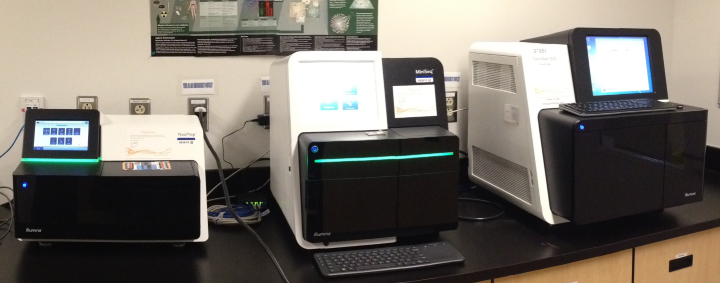Illumina Next Generation Sequencing Facility
Overview
Next generation sequencing (NGS) has rapidly become the state of the art for high-throughput
genomic analyses. This robust technology provides access to numerous applications
ranging from genomic (re)sequencing, whole-transcriptome analysis, small RNA, miRNA,
non-coding RNA, targeted sequencing, ChIP-Seq and ATAC-Seq. Using a massively parallel
sequencing approach, NGS is capable of generating gigabases of high quality sequence,
maximizing throughput while minimizing the cost and time to generate this data.
Infrastructure funding for this facility has been provided through a partnership
with The Ottawa Hospital to provide research capacity to the Eastern Ontario Regional
Laboratory Association (EORLA) personalized medicine initiative and by the Canadian
Foundation for Innovation.
Facility

StemCore's Next Generation Sequencing Facility is equipped with Illumina's NextSeq 500
and MiniSeq. Our
facility also has access to the new NextSeq 2000 located at the University of Ottawa
Centre for Advanced
Research in Environmental Genomics (CAREG). The NextSeq 2000 employs the proven
sequencing by synthesis
(SBS) technology, and innovative patterned flow cell technology which delivers significant increases in
sequencing reads and total output.
With these instruments StemCore can provide access to a wide variety of scalable next generation
sequencing (NGS) applications with data ranging from 7.5 Gb up to 360 Gb generated per sequencing run.
These platforms deliver high quality data with reduced cycle and data processing times and allow greater
flexibility in experimental design and faster turn-around-times for small to large scale projects.
Sequencing Platform Comparison
| Applications | Amplicon, targeted RNA, small RNA, targeted gene panels, small genome | Exome, transcriptome, ChIP-Seq, targeted resequencing | WGS, Exome, transcriptome, ChIP-Seq, targeted resequencing |
| Max Output | 7.5 Gb | 120 Gb | 360 Gb |
| Max Read Length | 2x150 bases | 2x150 bases | 2x150 bases |
| Max Reads per Run | 25 million | 400 million | 1.2 billion |
| Run Time | 4-24 hours | 12-30 hours | 10-48 hours |
Services
- Nucleic Acid Quality Assessment and Quantitation
- Library Construction
- Library Sequencing
- StemCore or User Prepared
- Consultation
- Experimental Design
- Pilot Projects
- Proof of Concept Experiments
- Grant Support
- Manuscript Preparation
- We will provide all support necessary to bring your project to successful completion.
- Please contact Damian Carragher to discuss
NGS Services, Pricing and Sample Submission Guidelines
-
A Master Service Agreement must be established and signed by the PI and Institutional Signing
Authority (external clients) for each project prior to processing samples. The agreement will be in
effect for three years from the time of signing.
-
All NGS service requests must be entered and approved in UOttawa
Infinity Idea Elan prior to
sample submission
- Samples should be accurately quantitated using a fluorometric method (PicoGreen, RiboGreen, or Qubit). StemCore Laboratories is able to perform these
assays for a nominal fee. NanoDrop readings are not accurate at the very dilute
concentrations utilized in next generation sequencing protocols, especially for
ChIP-Seq applications.
- StemCore is experienced in a wide variety of library preparation protocols. If your
application is not listed below please contact us to discuss.
- Input samples and NGS libraries will be stored for a limited period after which
the PI will be notified to retrieve the samples if desired, otherwise samples will
be discarded.
- Please contact StemCore for library preparation and sequencing pricing.
Deliverables and Results Retrieval
In most cases, BaseSpace will be utilized to facilitate transfer ownership of data. When sequencing is
complete, you will be provided a link to facilitate this transfer. More information regarding BaseSpace
and data transfer can be found here: https://knowledge.illumina.com/software/cloud-software/software-cloud-software-reference_material-list/000002876
In cases where data transfer cannot occur within BaseSpace, you will be provided directions to obtain
your data electronically.
StemCore will not archive analysis files once the data has been provided.
Next Generation Sequencing Resources
A wealth of information regarding next generation sequencing is available on the
internet. While this list is by no means meant to be exhaustive it provides links
to some helpful sites for next generation sequencing applications, protocols, guidelines,
and analysis tools:
Mailing Address
Ottawa Hospital Research Institute
Sprott Center for Stem Cell Research
StemCore Laboratories
Room 5132, Critical Care Wing
501 Smyth Road
Ottawa, Ontario, Canada K1H 8L6
Contact Information
Caroline Vergette
cvergette@ohri.ca
613.737.8899 x73251 (lab phone)
613.739.6294 (fax)
Damian Carragher
dcarragher@ohri.ca
613.737.8899 x73110 (office)
